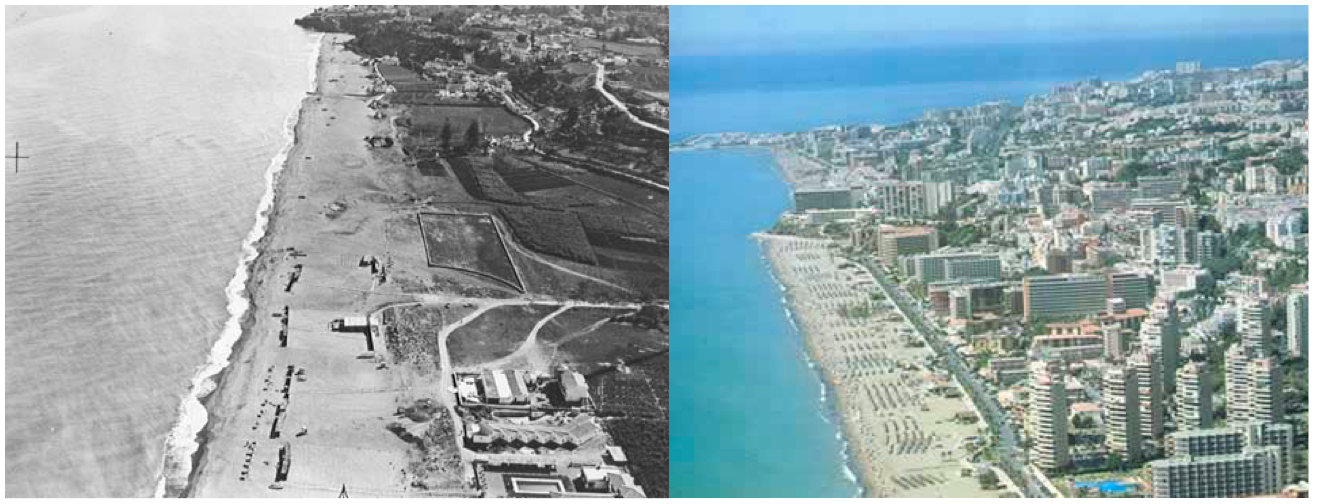
Uploaded on 2016-04-08 by Eduardo_Jimenez
Las Vegas (7.3°F),Albuquerque (5.9°F), Denver (4.9°F), Portland (4.8°F), Louisville (4.8°F), Washington, D.C. (4.7°F), Kansas City (4.6°F), Columbus (4.4°F), Minneapolis (4.3°F), Seattle (4.1°F) Which are the main UHI effects that you can identify in your area? Since 1960s, the urban and infrastructure development derived from tourism exploitation has become Torremolinos into a recognizable touristic city. Yet this type of development ends to the saturation of the urban system with some problems related to resident mobility and environment. UHI is one of these negative consequences. Torremolinos has grown rapidly in 50 years increasing the urban area from 17 Ha in 1957 to 907 Ha in 2007. This urban sprawl has replaced almost completely natural surface by built-surfaces, also its growing has caused a process of densification of population (from 3.000 hab. in 1957 to 60.000 in 2007), and this expansion leads to an increase in car use. Those are the main factors that cause the UHI effects. ![][1] ![][2] Although there is no data, the UHI modifies summer’s temperature average range approximately from a high of 40 degrees Celsius in the city to a low of 30 in the rural area. Furthermore, UHI negatively impacts the environment mainly by the production of pollution and it is also playing a major role in the local climate change, with greater periods of drought and greater occurrence of intensive localised precipitation. In addition, the covering of the soil surface increases torrential rainfall effects. In any case, planning for the sustainable development of Mediterranean tourism is thus seen as a key factor in future developments. ![Torremolinos, 1957 (izq.) y 1980 (der.). Ilustración extraída de Lacuey, José, 1990, Torremolinos. Torremolinos (Málaga): Ayuntamiento de Torremolinos][3] Which are the measures you would propose? I would propose four main strategies in order to reduce UHI in my community: 1) Trees and vegetation around city buildings. Increasing trees and vegetative cover, by providing shade and cooling, lowers surface and air temperatures. 2) Installation of green roofs over city buildings. It is particularly important not only to prevent the building's roof from absorbing heat, but cools the air around it. 3) Cool Pavements. Using paving materials on streets that remain cooler than conventional pavements (by reflecting more solar energy and enhancing water evaporation) 4) Increasing walkability and make more transportation available. 5) Smart Growth. These practices cover a range of development and conservation strategies that help to protect the natural environment and, at the same time, they make our communities more attractive, economically stronger, and more liveable. Is UHI effect concerning policy making in your area? No, I’m not aware of any UHI policy in Torremolinos. Malaga Local Administration has development planning strategies and actions within Agenda21 in accordance with Aalborg+10 obligations. One of the planning strategies is the reduction of UHI effects increasing quantity and quality of vegetation on public spaces. In fact, parks and vegetation are the first and best line of defence against UHI. Urban parks cool and clean the air, improve and modify local wind circulations, and regulate precipitation patterns. Well-vegetated parks, in a variety of forms and sizes, are one of the goals of OMAU (Observatorio del Medio Ambiente Urbano) according to the following criteria: 1. – Square meter of green spaces per inhabitant. 2. – Number of planted trees per inhabitant. 3. – Canopy density under shade conditions. 4. – Proportion of autochthonous species. [1]: https://edxuploads.s3.amazonaws.com/14601445367683214.png [2]: https://edxuploads.s3.amazonaws.com/14601446025528118.png [3]: https://edxuploads.s3.amazonaws.com/14601454449615906.png